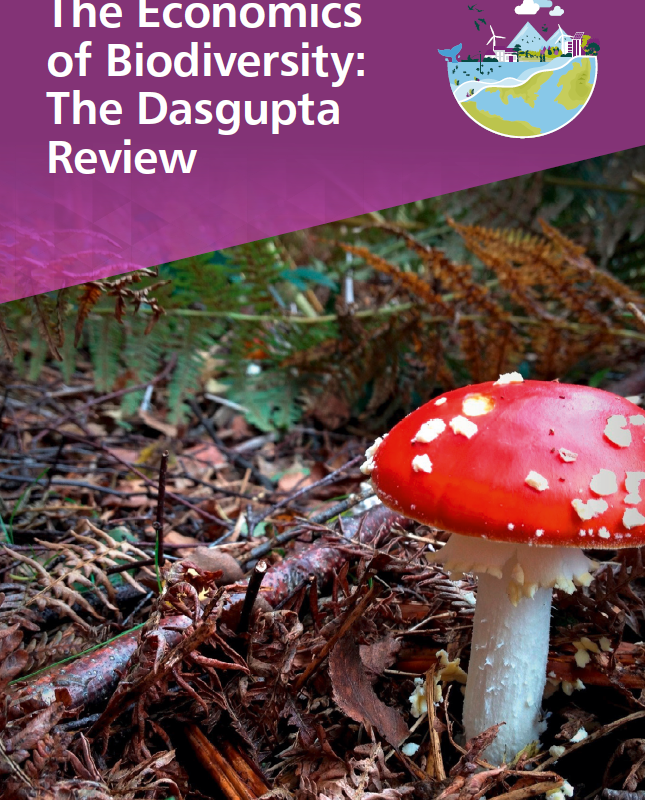 Alan Thornett reviews ‘The Economics of Biodiversity: The Dasgupta Review’ published by the UK Treasury in February 2021.[i]
Alan Thornett reviews ‘The Economics of Biodiversity: The Dasgupta Review’ published by the UK Treasury in February 2021.[i]
The (600-page) –‘The Economics of Biodiversity: The Dasgupta Review’ – published by the UK Treasury on February 2nd is a response to the ever-increasing, and undeniable, reality that human society is trashing the life-support systems of the planet at an ever-increasing and ever-more destructive rate, which, if it continues, could destroy the ability of the planet to sustain human life within a few decades.
Its principal author is Partha Dasgupta, a professor of economics at St John’s College Cambridge and it focusses on the economics of the ecological crisis, with a research team provided by the Treasury. It is inevitably written in scientific/academic language but remains accessible to non-academics such as myself.
The Review was commissioned – remarkably and paradoxically – by Philip Hammond as a Tory Chancellor of the Exchequer – under the government’s so-called ‘Open Government license’. This is similar to the way that the previous blockbuster environmental study – the 700 page ‘The Stern Review – The Economics of Climate Change’ – was commissioned by Gordon Brown and also published by the Treasury, in 2007.
It is published in advance of two crucial environmental events: COP 15 (of the UN Convention on Biological Diversity) in Kunming China and COP 26 (on climate change) in Glasgow at the end of the year. Both give it added significance.
The Review claims to be – and clearly is – independent of government, despite its highly dubious origins. In fact it carries a bold, indeed radical, message that is long overdue. This is reflected first in Dasgupta’s decision to put biodiversity – seen by many in the past, including on the radical left, as of secondary importance – at the heart of the Review. Scientists have, in any case, now recognised that we are currently going through the greatest species extinction event since the demise of the dinosaurs 65 million years ago.
This is also reflected in his decision to give a central prominence to the pivotal issue of growth, both economic and demographic. Issues that has been debated for a long time – by the degrowth movement for example – but never resolved or adopted mainstream. They are, however, becoming increasingly difficult to avoid.[ii] [iii] It certainly gave me a shock on my first reading of the Review.
The public launch
All this made the public launch of the Review (on February 2nd) an incongruous event.[iv] The panel was headed up by Prince Charles (no less), with David Attenborough and Boris Johnson, George Eustice (minister of agriculture), and Dasgupta himself. Praise was heaped on The Review for the prominence it affords to biodiversity. David Attenborough was most graphic:
“We ourselves, together with the livestock we rear for food, constitute 96% of the mass of all mammals on the planet. Only 4% is everything else – from elephants to badgers, from moose to monkeys. And 70% of all birds alive at this moment are poultry – mostly chickens for us to eat. We are destroying biodiversity, the very characteristic that until recently enabled the natural world to flourish so abundantly. If we continue this damage, whole ecosystems will collapse”.
The Review puts it this way:
“Largely as a result of human activities … [c]urrent extinction rates of species in various orders are estimated to have risen to 100-1,000 times the average extinction rate over the past tens of millions of years (the ‘background rate’) of 0.1-1 per million species per year (expressed as E/MSY)[v], and are continuing to rise. To illustrate in absolute terms, 1,000 species would become extinct every year if the number of species was 10 million and 100 E/MSY was the current extinction rate.” [vi]
The issue of growth of either variety, however, was completely absent from the event – other than from Dasgupta himself. It was the unmentionable elephant in the room. Yet it is precisely on this issue that Dasgupta Review goes a long way beyond the Stern Review.
Although Stern defended the science of climate change, and refuted the deniers, he was strongly in favour of economic growth, and had nothing to say about population. In fact he insisted that tackling climate change “is the pro-growth strategy for the longer term”, and argued that it can be done in a way that does not cap the aspirations for growth of either rich or poor countries.
The Limits to Growth report
Growth is also the issue where the Dasgupta Review reflects one of the most influential (and best-selling) environmental books of the 20th century ‘The Limits to Growth’ by Donella and Dennis Meadows (with Jorgen Randers and William Behrens) published in 1972.[vii] In fact it shares a central thesis with it. Namely that exponential growth, of either the economic or demographic variety, is impossible on a finite planet without its ecosystems systems sooner or later collapsing.
The Limits puts it this way:
“If the present growth trends in world population, industrialisation, pollution, food production, and resource depletion continues unchanged, the limits to growth on this planet will be reached sometime within the next one hundred years”.[viii] In fact this has turned out to be a remarkably accurate prediction with many environmentalists today predicting such collapses by mid-21st century.
The Review puts it this way:
“The World population in 1950 [just before I left school – AT] was around 2.5 billion and global output of final goods and services (i.e. global GDP) at 2011 prices was around 9 trillion international dollars (i.e. dollars at purchasing price parity (PPP)).The average person’s annual income was around 3,300 dollars at PPP, a high figure by historical standards. Since then the world has prospered beyond recognition. Life expectancy at birth in 1950 was 46; today it is around 73. The proportion of the world’s population living in absolute poverty (currently 1.90 dollars per day) has fallen from nearly 60% in 1950 to less than 10% today. By 2019, the global population had grown to over 7.7 billion even while global GDP per capita had risen to around 16,000 dollars PPP (at 2011 prices).
“The world’s output of final goods and services was now a bit above 120 trillion dollars PPP (at 2011 prices), meaning that globally measured economic activity had increased more than 13-fold in only 70 years, a rate of increase that had never remotely been experienced before.”[ix] [x]
The Review accepts the current UN projection that the global population will rise to around 10.9 billion by 2100, against 7.7 billion today, which is completely unsustainable.
It also argues (rightly) that economic growth and population growth are indivisible phenomenon: i.e. you can’t contain economic growth without containing population growth. Global GDP, it insists, is the product of four factors: “population size; per capita GDP, and the efficiency with which we convert the biosphere’s goods and services into GDP, and the extent to which the biosphere is transformed by global waste disposal”. These factors, it says, “are not independent of one another and are, in any case, the outcome of our own choices.” [xi]
The Review’s key conclusions
The two most significant conclusion that the Review reaches from all this is that there has to be:
- a reduction in per capita global consumption; and
- a reduction in the global human population, if serious progress is to be made.[xii]
The call for a reduction in the human population rather than (just) stabilisation – as I have advocated for example – is argued as follows:
“A population can be stable, but if large it would [still] have a big footprint, other things equal, and could bring the biosphere into disrepair. That is why the replacement fertility rate is not as significant a notion as ‘fertility transition’ (the transition from high fertility rates to the replacement rate) in the economics of biodiversity as it is in demography. The economics of biodiversity encourages us to look for transitions that dip below the replacement fertility rate before tending toward it.” [xiii]
Everything it proposes, therefore, is in line with basic human rights and social justice demands put forward by the women’s movement itself and is in line with the decisions of the UN Conference on Population and Development in Cairo the 1994. That conference adopted a detailed Programme of Action which was exclusively based on the empowerment of women from education to reproductive rights which governments were required to implement within a fifteen-year period.[xiv] The implementation of this, however, was derailed by a massive pro-life campaign led by the Vatican.
The Review also spells out the scale of the problem which has to be met first and foremost for basic human rights and social justice considerations – i.e. a woman’s right to choose – and also for population reduction.
“The rationale for vigorously expanding the content and reach of such programmes today also lies in the more than 215 million women in developing, mainly low income, countries who have reported they want to prevent pregnancy but are not using modern contraception. Among them, over 150 million use no method of contraception and nearly 65 million rely on traditional methods (UNPD 2020). The Guttmacher Institute (2020) estimated that there were some 110 million pregnancies in low and middle income countries annually that were unintended. The institute also estimated that if all unmet needs for modern contraception were satisfied in developing countries, there would be a nearly 70% decline in unintended pregnancies, amounting to around 35 million a year. Meeting unmet needs for contraception would reduce pregnancy-related deaths by 70,000. Many unintended pregnancies end in abortion, a significant proportion of which are performed under unsafe conditions.”[xv]
Conclusion
This Review should be strongly welcomed by the environmental movement, which should insist that it is taken seriously by government. Johnson, of course, would like to kick it into the long grass as quickly as possible, and is already trying to do so. You only have to contrast the promotion and profile that the Tories are giving it to the report of the Commission on Race and Ethnic Disparities, which (outrageously) let them off the hook on their deeply ingrained institutional racism, to see where they are coming from. The environmental movement and the left must ensure that he is not successful when it comes to the Review.
Equally, concepts of growth are highly popular with ruling elites, of course, who see in expanding markets, higher profits, workers for factories and services, and soldiers for the battlefields. The Dasgupta Review challenges their conception head on. Again, we must ensure that they do not get away with it.
The Review, it has to be said, does not finish as strongly as it starts. It rightly insists, in its introduction to Part 2 The Road Ahead, that:
“Humanity now faces a choice: we can continue down a path where our demands on Nature far exceed its capacity to meet them on a sustainable basis; or we can take a different path, one where our engagements with Nature are not only sustainable but also enhance our collective well-being and that of our descendants.” [xvi]
]And it goes on] “Although time is not on our side it is not too late for us, both individually and collectively, to make the conscious decision to change paths. Our descendants deserve nothing less.” [xvii]
Despite this, it lacks an exit strategy from fossil energy that can be achieved within the timescale available – which is less than 10 years in terms of climate change and who knows in terms of future pandemics. While it rightly advocates eco-taxes to bring about environmental change, it does not do so at the scale that is necessary to be effective. Nor does it, unsurprisingly, have any concept of change via a mass movement of progressive forces.
In fairness, it rightly calls for massive investment in an ecological transition of the scale of the Marshall Plan by which the USA refunded the reconstruction of Europe in the post-war period. Dasgupta puts it this way: “If we are to enhance the biosphere’s health and reduce our demands, large-scale changes will be required, underpinned by levels of ambition, coordination and political will akin to (or even greater than) those of the Marshall Plan”.[xviii]
It also rightly argues that such investment should address the conservation and restoration of the ecosystems; strengthening the protected areas; major changes in agricultural practices, and a major and sustainable reduction in the human ecological footprint. The current global divisions of wealth, it argues, would have to go “since the universal achievement of contemporary lifestyles in high income countries would require resources several times the sustainable level (O’Neill et al. 2018)”. [xix]
Radical left environmentalists, and the wider environmental movement, must ensure that this Review, and the crucial issues it raises, are a factor in the Glasgow COP itself – which will be presided over by the same British government that just commissioned and published it, but are now bent on disowning it.
Finally, when critiquing the Review, the radical left should remember what it is. It is not for example a revolutionary programme – although it contains demands, around growth in particular, that are incompatible with the logic of capitalist accumulation – and anyone who critiques it for not being such, or the editorial team for not being a revolutionary party, will end up asking the wrong questions.
If you ask, for example, ‘does it aim to end capitalism’ the answer will be no. If that were its aim it would not be published by the UK Treasury and Dasgupta would not have got the job in the first place. It you ask, however, does it have analysis or indeed proposals that can take the movement forward, then the answer must be yes. Our job must be to identify the valuable bits and promote them as hard as we can.
[i] Can be found at: https://www.gov.uk/government/publications/final-report-the-economics-of-biodiversity-the-dasgupta-review
[ii] They are also issues that I have written about and campaigned around over the past 10 years and along the lines the Review advocates. These debates can be found in my book Facing the Apocalypse – Arguments for Ecosocialism published in 2019.
[iii] I wrote an article in May 2016 entitled The biodiversity crisis and the environmentalist left in which was write up from a presentation I made at Historical Materialism in 2015. It can be found at: https://socialistresistance.org/the-biodiversity-crisis-and-the-environmentalist-left/7410
[iv] The launch webinar can found be at: https://www.youtube.com/watch?v=e2QDOeKH0DE
[v] Background extinction rate.
[vi] Box 5 abridged version
[vii] ‘The Limits to Growth – a report to the Club of Rome’s project on the Predicament of Mankind. ’Published in 1972 by Universal Books NY.
[viii] Point 1 of their conclusions.
[ix] An exponential global growth rate of 3 per cent (for example) – which has prevailed for the past 70 years – would grow the world economy by a factor of sixteen in the course of one century and by 250 in the course of two.
[x] p.26 abridged version
[xi] p.29 abridged version
[xii] P.37 abridged version
[xiii] p.37 abridged version
[xiv] The UN International Conference on Population and Development, Cairo,1994.
[xv] p. 38 Box 8 abridged version
[xvi] p.69 abridged version
[xvii] p.70 abridged version
[xviii] p.70 abridged version
[xix] P.71 abridged version




One thought on “A Radical Departure- the Dasgupta Review”